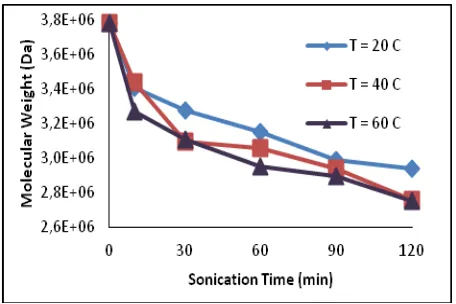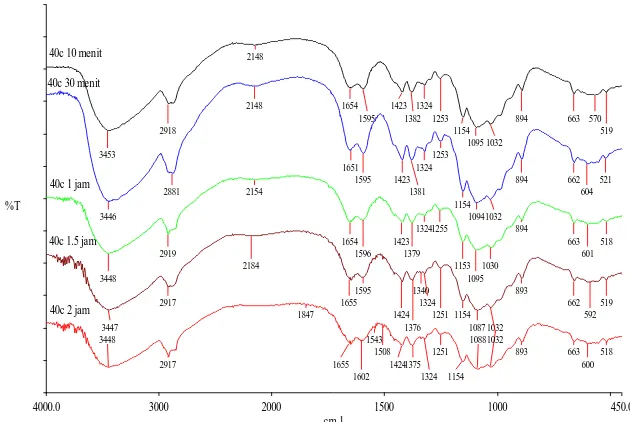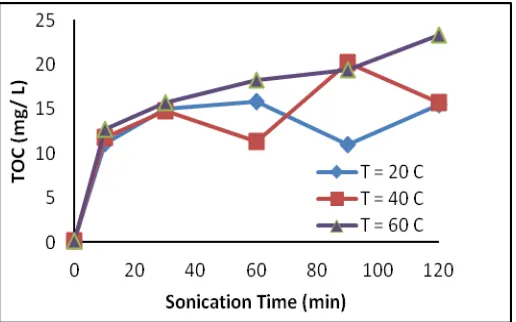The Effect of Sonication on The Characteristic of
Chitosan
Azra Yuliana, Linggar S. Pradeckta, Emma Savitri, Anita R. Handaratri, Sumarno
Chemical Engineering Department, Faculty of Industry Technology, Sepuluh Nopember Institut of Technology Surabaya Jl. Arief Rahman Hakim, Surabaya INDONESIA
Email : [email protected]
Abstract :
This research aim was to study the effect of sonication process on the changes of chitosan characteristics such as molecular weight,chemical structure, degree of crystallinity and the amount of dissolved chitosan after sonication. Sonication process was conducted on a mixture of chitosan-bidest 1% (w/v) in a glass reactor during 10 - 120 minutes at temperature 20, 40, 60 oC and frequency sonication of 20 kHz. The sonication probe was inserted into a mixture of chitosan-bidest in the reactor, and sonication was performed on selected time and temperature sonication. After sonication, solid residue was filtered and dried before analyzed by viscometry, FTIR, XRD, and TOC to determine the changes of molecular weight, chemical structure, crystallinity, and the amount of the total organic carbon dissolved in the system. The results showed that molecular weight and degree of crystallinity of chitosan decreased for longer sonication time and higher temperature system. Moreover, the chemical structure was no changes on functional groups significantly and it was indicated that there were no new compounds formed. Total organic carbon from which degraded chitosan also increased for further sonication time because more organic carbon was dissolved in the system.
Keywords: chitosan, degree of crystallinity, molecular weight, sonication
1. Introduction
Chitosan is a de-acetylation product of chitin which is the second largest natural biopolymer after cellulose in the world, which are founded in insects, crustaceans, and fungi. The development of new applications of chitosan is supported by the availability of this polysaccharide abundantly in nature, besides it is biocompatible, biodegradable, non toxic, having antibacterial properties, polyelectrolytes and save for the environment. In the aspect of medicine and pharmacy, chitosan is used as a wound dressing, grafts for organ tissues (bone, connective tissue, and others), activated substances for controlling blood cholesterol, drug deliverys and activated substances for antitumor. The suitability of chitosan’s characteristics is required for their applications in the medical sector such as chemical, physical, toxicity, and morphology and mechanica properties. Chitosan is also used in many other industries, such as sewage treatments, especially to minimize heavy metal because of its polyelectrolyte properties, cosmetics, agro-industry, textile, wood and paper industry. For application in food industry, chitosan can coagulate oils/fats, reduce turbidity, apply as oil stabilizer, flavor and fat in food products [1].
Generally, chitosan obtained from chitin de-acetylation process have a high molecular weight and low solubility in water. Unfortunately, low solubility of chitosan in water, high molecular weight and viscosity restricted its applications in medicine, pharmacy and food industries. To improve the properties of chitosan, Chitosan is degraded to obtain chitosan with low molecular weight (Low Molecular Weight Chitosan, LMWC), oligomers (chitooligomers, COS) and glucosamine which are soluble in water. Chitosan with low molecular weight and good solubility in water or neutral pH will have a great potential in applications, especially in improving food quality and human health [2]. In addition, the important concern from the degradation of chitosan is a monomer product, that is glucosamine, has great potential in medicine and pharmacy. N-Acetyl-D-Glucosamine or glucosamine are products of monosaccharide, which have produced from chitin or chitosan by hydrolysis process. Glucosamine is classified as hexosamin and a water-soluble compound. In general, glucosamine is used by patients with osteoarthritis. The ability of glucosamine synthesis in the body decreases with increasing the age of human. Hence, Glucosamine has been approved by the Food and Drug Administration as a dietary supplement [2].
of them are often used on an industrial scale. Enzymatic processis usually more easy to be operated because it is done in a batch reactor,but it is not economically process compared with chemical hydrolysis process [2].
The study was conducted by Kimet al (2005) on chitosan hydrolysis to produce CO Susing enzymaticprocesses. The resultisthe enzymatic hydrolysis easiest operate, save for the environment, non-toxicbut it is not economically profitable [2]. Mourya (2011) was study chitosan depolymerization with concentrated hydrocloric acid 10,2 M ocure in disticnt steps, that is, depolymerization of the polysaccharide to smaller polymeric units, the production of N-acetyl-glucosamine from the latter, and the conversion of N-acetyl-glucosamine into glucosamine and acetic acid. In highly concentrated hydrochloric acid (12,07 M), the rate hydrolysis of glycosidic linkage was found to be ten times higher than the rate of N-acetyl-glucosamine. In concentrated hydrocloric acid 12 M, temperature 40oC and reaction time 0,5 - 8 hours, produced chitosan oligomers with DP of 1- 3 kDa. Concentrated hydrocloric acid 4 M, temperature 100oC and reaction time 15 hours, produced chitosan oligomers with DP of 21 kDa and concentrated hydrocloric acid 0,8 – 2,5 M, temperature 80oC and reaction time 2 hours, produced chitosan oligomers with DP of 3,5 kDa. This method has some disadvantages such as low yield, partial deacetylation of the resulting oligomers, difficulty of controlling depolymerization, cumbersome isolation of oligomers mixture, residual acidity and high cost [4]. Czechowska et.al. (2005) were studied effects of 360-kHz ultrasound on aqueous solutions ofchitosan and starch for reduction of molecular weight of both polysaccharides. It has been demonstrated that at the applied ultrasund frequency degradation is caused both by OH radicals and mechanochemical effects. In Ar-saturated 2 x 10-2 mol dm-3 chitosan solutions, pH 3 at an ultrasound dose rate 170 W kg-1, the average sonochemical chain scission yield in the sonication time range of 0 – 90 min is ca. 8 x 10-11 mol J-1[5].
Therefore it is necessary for degradation of chitosan efforts through effective and efficient method to generate oligochitosan and glucosamine. One attempt to do for the process is to do with the ultrasonic degradation process. Process is asave for the environment technology and highly effective in the degradation process. In the ultrasonic process can degradation large molecular weight chitosan into chitosan with moderate molecular weight
[6]. With the abovemethods are expected to obtain oligomers of chitosan that need further research.
2. Materials and methods
2. 1. Materials
Chitosan Powder obtained from Biotech Surindo, Cirebon, Indonesia. Bidest medical grade and acetic acid glacial 98%.
2. 2. Methods
Preparation of the reactans
Bidest mixed with chitosan powder with a ratio of chitosan: bidest=2: 200 (mass: volume).
Initial treatment of sonication
Sonication process is done in several variables, that is temperature20, 40, 60 ° Cfor 10, 30, 60, 90, 120 min. Mixture of chitosan-bidest put into glass beaker, then the sonication probe inserted into the glass beaker containing a mixture of chitosan-bidest, and conducted sonication accordance sonication time and temperature. Frequency of 20kHz isused. The same is done for other variables of time and temperature.
Sampling
Sampling process is done by separating the mixture of sonication from filtrate and solid. The solid was dried in the oven while the filtrate is stored in glass bottles.
3. Result and discussions
chitosan with high molecular weight to moderate molecular weight so at the hydrothermal process would easily to producing chitosan oligomers.
3.1. The result analysis of product after sonication process
3.1.1. The result analysis of molecular weight (vicsosimetry method)
Molecular weight was analysed by vicsosimetry method to determine molecular weight of the solid residue after sonication process. Parent and degraded chitosan molecular weight calculated by Mark Houwink equation:
The molecular weight of parent chitosan was about 3,783. 106 Da. While the molecular weight of solid residue after sonication process is shown in Figure 1. The figure display that increasing duration of sonication time causes molecular weight of parent chitosan decrease up to 2.751. 106Da. Decreasing molecular weight because of mechanical and chemical effect that was occurred during sonication process. Mechanical effect is phenomenon that cavitation bubbles were collapsed because of high temperature about 1000 atm and rate of local heating above 109 0C/s on liquid [5]. On sonication process, heat that produced from explosion of cavitation can decomposed water to be a reactive hydrogen atom and hydroksil radical. During fast cooling phase, hydrogen atom and hydroksil radical recombine to form hydrogen perokside and hydrogen molecule [7].
Figure 1. The relationship between sonication time versus molecular weight at various temperatures
Figure 1 can be observed that the decreasing rate of molecular weight at 60 ° C is higher than those of 40 0C and 20 0C. This is appropriate with price (1992) that maximum temperature produces from cavitation process is proportional with ambient temperature from sonication system [8]. The maximum temperature gives an effect on radical formation that responsible to break glycosidic bond. After sonication process, there are changes in molecular weight at temperature 20, 40, and 60 oC has each value 22,34; 27,02; 27,26 %, respectively than molecular weight parent chitosan. From this reference is shown that polymer degradation with sonication process has similar process with radiation induction, where the process is not occur randomly but just until specific limit of chains [5].
3.1.2. The result analysis of FTIR(Fourier Transform Infrared)
4000.0 3000 2000 1500 1000 450.0
Figure 2. The Spectogram of FTIR for chitosan after sonication process at temperature 40oC on different time of sonication
3.1.3. The result analysis of XRD
XRD analysis aimed to determine the changes of crystallinity of chitosan after the sonication process. From diffractogram of XRD, the changes of crystallinity of chitosan residue appear at the 2Ө about 110 and 190. At 2Ө=110 , the intensity of peak has increased. According to Mourya (2011) this peak is associated with water molecules bound to the intermolecular structure of chitosan (Bounded Water) [4]. The intensity characteristic of the peak tends to increase with increasing duration of sonication time. Moreover, there are changes at peak 2Ө = 190. The peak looks more narrow that indicates decreasing in crystallinity. This assigned destruction of chitosan crystal. This phenomenon is supported by Mourya (2011) that the longer time of sonication, it will damage the crystal structure of chitosan [4]. From the Figure 3, it can be seen a decrease in the crystallinity of chitosan at sonication of each temperature sonication. The longer the sonication time, the crystallinity of chitosan initially declined 19.16% up to 9.03%. Decrease in crystallinity occurs due to destruction of the crystalline structure of chitosan. This is an effect of the collaps of cavitation. Moreover, Most of the changes on degree of crystallinity is shown in sonication at temperature 400C. Although, according to Price,the maximum temperature that result during the collapse of the cavitation bubble is proportional to thetemperature of the system during the process of sonication [8].
3.1.3. The result analysis of TOC
TOC analysis aims to determine the amount of organic carbon dissolvedin the filtrate as a result of sonication. At Figure 4. TOC values tend to increase with sonication time. It can be seen in Figure 4, TOC values increase from 11.12931 mg/L to about 23.26156 mg/L. The rate of increasing on the amount of organic carbon dissolved at the beginning of the sonication time is higher than that at the end of theprocess. This phenomenon is similar to the rate of decreasing molecular weight. Degradation of chitosan will stop when it reaches a certain chain length of the boundary conditions. This is suggests that the longer the sonication time, the more dissolved organic carbon in the system as a result of the degradation of chitosan during the sonication process.
Figure 4. The relationship between sonication time versus TOC at various temperatures
4. Conclusion
The effect of sonication process variables on physical and chemical properties (molecular weight, total organic carbon (TOC), the degree of deacetylation, molecular structure, degree of crystallinity) of low molecular weight chitosan, that are :
The longer the sonication time make the molecular weight decreases, the changes are around 22.34 to 27.26% of the initial molecular weight of chitosan.
Molecular weight chitosan can be shown by the increase of TOC in the solution.
The results of spektogram FTIR analysis is not show a change in functional group and a new group with increasing duration of the sonication.
The longer the sonication time make the degree of crystallinity decreased from 19.16% to 9.04%.
Acknowledgement
The author A.Y. and L.S.P. thanks to The Directorate of Higher Education, Ministry of National Education Republic of Indonesia which has provided financial support through The Student Creativity Program for Research(PKMP). In addition authors also thanks to Emma Savitri, ST, M.Sc on the advice and guidance has been given.
References
[1] Kaban, Jamaran. 2009. Modifikasi Kimia dari Kitosan dan Aplikasi Produk yang Dihasilkan.
[2] Kim, Se K, dkk. 2005. Enzymatic Production and Biological Activies of Chitosan Oligosaccharides (COS) [3] Rukayadi, Yaya. 2002. Kitin Deasetilasi dan Pemanfaatannya
[4] Mourya, V.K, dkk. 2011. Chitooligosaccharides: Synthesis, Characterization and Application. [5] Czechowska, Renata, dkk. 2005. Degradation of chitosan and starch by 360-kHz ultrasound.
[6] Kasaai, Mohammad R. 2007. A Review of Several Reported Procedures to Determine The Degree of N-acetylation for Chitin and Chitosan Using Infrared Spectroscoy.
[7] Tian, Feng dkk. 2004. Study of the depolymerization behavior of chitosan by hydrogen peroxide.


